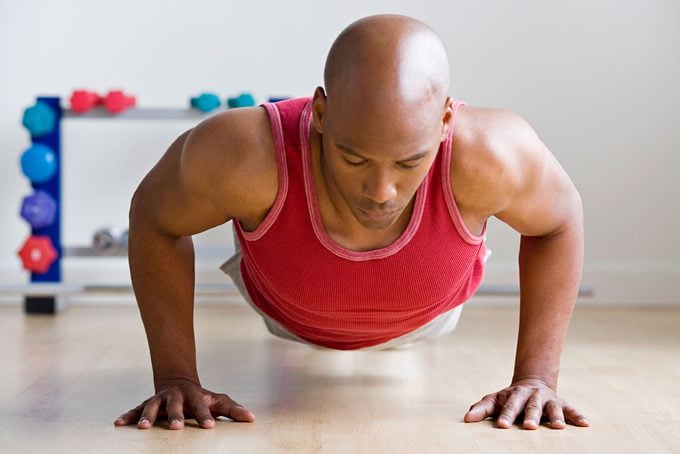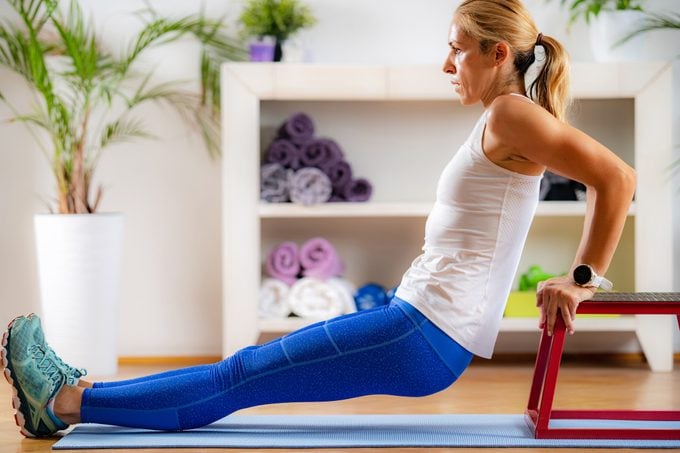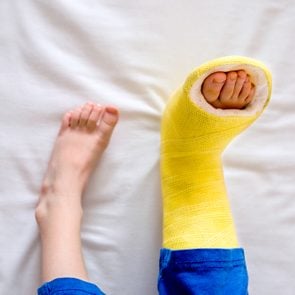The 4 Best Exercises to Strengthen Bones in Your Upper Body, From an Exercise Physiologist
Updated: Mar. 07, 2022
Walking is great for lower-body bone health—but, it's not really strengthening your arms or shoulders. Learn how a certified exercise physiologist says you can boost bone strength in your upper body with a few simple (and dare we say, fun?) moves.
How to strengthen bones
We’ve all got our own reasons for working out. For you, maybe it’s to feel fit or because working out is so good for your mind, or another reason completely. But what makes exercise even more beneficial is the research-backed link between regular exercise, developing stronger bones, and improving your long-term bone health. The very best exercises to strengthen bones happen to be weight-bearing moves that force your bones to support your body.
But what you might not realize is that, just as strength-training is muscle-specific—as in, a biceps curl only builds your biceps, not your glutes—exercising to enhance bone health is bone-specific. So while walking (which is currently more popular than ever) and squats are good for lower-body bone health, they’re not going to do a whole lot to improve bone strength in your upper body. That’s why, if you’re counting on your usual workout to help maintain and even prolong your bone health, you need to make sure you have a well-balanced, total-body routine.
Here’s how to strengthen your bones with a few basic exercises and tips. (Inspired already? Also check out these 30 simple ways to build bone density.)
How to strengthen bones with exercise
It’s easy to think of a bone as a hard, fixed object… but, there’s actually a lot more going on. “Your bones are alive!” says Jess Hiestand, a NASM-certified trainer and group fitness instructor. “Really—bones are living tissues, and they respond to the stress you place on them.”
This trainer explains that your bones are constantly building up and breaking down, but this pattern shifts over time. “When you’re a child and adolescent, bones build much quicker than they break down,” Hiestand says, explaining that bone growth begins to slow as you age. “Unfortunately, bone growth will become slower than bone loss if you don’t continue to place stress on your bones through exercise. This can lead to increased risk of fractures and lower quality of life.”
This is one of the many reasons continuing to exercise throughout your lifetime is so important. As you get older, your bones’ cell turnover starts to favor breakdown over building. Then your body relies on the stress you place on it through exercise to help stimulate continued bone-building cell action.
The same basic rules apply to building bone in your lower and upper body, but the exercises that work your lower body won’t necessarily work your upper body. “Weight-bearing exercises and resistance training are effective at building upper-body bone density,” Hiestand says. “This means any movement where your body is fighting against gravity or external resistance can help you build bone density.”
When you perform weight-bearing exercises, particularly more intense exercises than the movements you would perform at work or around the house, your bones will perceive the exercises as a stressor and adapt by becoming stronger, Hiestand explains.
(Something to avoid when it comes to how to strengthen bones? These common habits that could zap your bone strength.)
Types of exercises for upper-body bone strength
To build bone strength in your upper-body, you have to choose exercises that bear weight (or force) in your upper-body. There are different approaches (or combinations of approaches) that can help you achieve this:
Strength training
The absolute best strength-training exercises for bone strength are closed-chain, compound movements. Pushups, pullups, and bench dips are all examples of these. Essentially, the hands remain fixed in one location, bearing the weight of the exercise, and multiple muscle groups (and bones) move together against the fixed point to perform the exercise.
Upper-body plyometrics
You may be familiar with lower-body plyometric (jumping) exercises, but you may be surprised to learn that many upper-body exercises can be plyometric, too. Essentially any exercise that involves a “jump” and a “land” in which the arms bear additional force and weight to “catch” the body (or an object) is considered plyometric.
For instance, clapping pushups, medicine ball tosses with a partner (throwing the ball is like a “jump” and catching the ball is like a “land”), or kipping pullups.
Low-impact weight-bearing exercises
Low-impact exercises that bear weight and force can help build bone in the upper-body. The perfect example for the lower body is walking—you bear the weight of your body in your legs, hips, and back as you take each step, encouraging cell turnover in your bones to help keep them strong.
Although there’s not a perfect comparison for an upper-body move, there are exercises that involve “walking” on your hands while supporting your upper-body. For instance, inchworm exercises where you walk your hands forward, or walking planks where you walk your hands and legs side-to-side, or crab walks.
Sports activities

Many sports activities can help build upper-body bone strength. Anything that bears weight or force (through catching, hitting, pulling, pushing, or pressing) would qualify. For instance, Hiestand points to tennis and rock climbing as good options, but you could also play basketball or add boxing workouts to your routine.
Any combination of these types of exercise done regularly will help fortify your bone health and keep your shoulders, arms, and upper back strong.
(On the topic of bone strength, learn how to prevent osteoporosis.)
Exercises for a home-based upper-body bone-building workout
For specific examples of a solid workout designed to help strengthen the bones in your upper-body, consider the following suggestions from Hiestand.
You can perform these exercises, along with other upper-body strength training moves to enjoy a workout that builds muscles, bones, and cardiovascular capacity all at the same time. Do these exercises back-to-back as a series, completing three total sets. Add other exercises as desired to round out the upper-body routine.
(This is how long it takes for your skeleton to regenerate.)
Pushups

Pushups work the muscles of your chest, triceps, and shoulders, as well as your core. And because you’re supporting your body weight with your arms, you’re stressing the bones of your arms, shoulders, and upper back all at once.
Start on a mat, placing your hands on the mat directly beneath your shoulders. Step your feet back to enter a high plank, your body weight fully supported by your hands and your feet. Engage your core and make sure you’re forming a straight line with your body from your heels to your head. Bend your elbows out and back at a roughly 45-degree angle from your body, slowly lowering your chest toward the floor. When your chest almost touches the mat, press through your palms and return to the high plank position.
Perform 10 to 15 repetitions. If you need to lower your knees to the floor to modify the pushup, feel free to do so, or switch to a wall pushup instead—you’ll still enjoy the muscle- and bone-strengthening benefits. And, as you become stronger, consider switching it to a plyometric pushup, hopping your hands into the air as you press back to the starting position. (Just be mindful that if you’re not certain of the strength in your wrists or elsewhere, you should give yourself plenty of time to work up to the plyometric attempt. Also, consider trying these 14 upper-body dumbbell exercises for more strength overall.)
Bear crawl
A bear crawl is one of the moves that builds bone as a low-impact, weight-bearing, upper-body “walk” of sorts.
Start on your hands and knees on a mat, with your hips over your knees, your shoulders over your hands. Engage your core and tuck your toes under. Lift your knees from the ground, but keep them low—close to the mat. From this position, crawl forward roughly four steps, then reverse the movement and crawl backward to the starting position. With each “step” of your hands, you’re absorbing the impact with your hands, wrists, elbows, and shoulders, building the strength in your bones. Continue crawling forward and backward for 60 seconds. Complete three sets.
You may also want to mix things up and try the childhood favorite: a crab walk exercise.
Triceps bench dips

Triceps dips are another closed-chain, weight-bearing exercise that helps strengthen the bones and muscles of the arms and shoulders. Sit on the edge of a very stable chair or a bench with your hands grasping the front edge, just outside your hips. Stretch your legs out in front of you, so that only your heels touch the ground. (If you haven’t ever done these or it’s been awhile, you can also modify this move by bending your knees to a 90-degree angle.)
Here’s where the work comes in. Press through your palms and lift your hips off the bench, shifting your weight forward slightly to position your hips in front of the bench. Bend your elbows, pointing them straight back, and lower your hips toward the ground. Allow your hips to naturally bend as you lower your torso toward the ground—you want your spine to stay at a 90-degree angle to the floor, not angled forward. When your elbows form a 90-degree angle, press through your palms and return to the starting position. Perform 10 to 15 repetitions.
Sprawls
Sprawls are similar to burpees, so if you’re familiar with that exercise, you’ll be familiar with this one. The beauty of the sprawl is that even though your lower body is doing the “jumping,” your upper-body supports the weight and impact, which makes this a type of plyometric for your upper-body, too. This provides an explosive power move to your routine that’s also lower impact.
Stand tall on a mat, your feet hip-distance apart, your knees slightly bent. Engage your core. Squat down and place your hands on the floor in front of your feet so your palms are aligned with your shoulders. Jump both feet back at the same time, landing in a high plank position—you’ll absorb much of this impact in your shoulders and arms. Hop your feet back to the starting position and stand up. Complete 15 repetitions.
With these great new ways to strengthen your bones, check out the best foods for your bones.



















